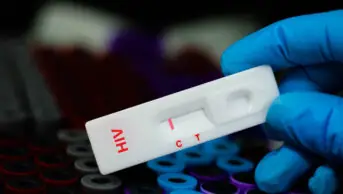
MAG/The Pharmaceutical Journal

Source: MAG/The Pharmaceutical Journal
Seven experts from across ophthalmology, optometry and pharmacy discuss the management of dry eye in community pharmacy at the Royal Pharmaceutical Society headquarters in London on 25 April 2016
On 25 April 2016, seven experts from across ophthalmology, optometry and pharmacy attended a round table event to discuss the management of dry eye in community pharmacy hosted by The Pharmaceutical Journal at the Royal Pharmaceutical Society (RPS) headquarters in London.
The event, which was held in partnership with UK health company RB, discussed the appropriate management of dry eye conditions in the pharmacy setting and identified the learning needs of pharmacy teams to support best clinical practice.
Prior to the event, The Pharmaceutical Journal conducted a survey of half the RPS’s 44,000 members to find out how frequently pharmacists encounter patients with a possible dry eye condition and to gauge the level of training that pharmacists receive to deal with them. More than 1,350 members responded and the results were presented at the round table discussion for consideration by the panel.
The survey posed the following scenario: “A patient comes into a pharmacy complaining of tired eyes that feel gritty. The patient does not wear contact lenses or take any medicine and works in an office. The symptoms started a week ago, and she has no other symptoms. What condition do you tell the patient she has?”
More than half of the 227 community pharmacists who responded to the survey diagnosed the patient with a dry eye condition, but the panel of experts said this is not the right conclusion.
More than 50% of survey respondents misdiagnosed dry eyes when there was not enough information by any means
“[Community pharmacists] need to ask the patient more questions,” said James Wolffsohn, an optometrist and deputy dean of the School of Life and Health Sciences at Aston University in Birmingham. “More than 50% [of survey respondents] misdiagnosed dry eyes when there was not enough information by any means.” However, 81% of community pharmacists reported that they feel somewhat or very confident diagnosing patients with dry eye.
Common conditions that might be confused with dry eye include bacterial conjunctivitis, hay fever and blepharitis. Among the community pharmacists surveyed, 7% diagnosed the hypothetical patient with either bacterial conjunctivitis or hay fever, while 41% correctly asserted that they did not have enough information to make a diagnosis.
According to the 2007 report of the Definition and Classification Subcommittee of the International Dry Eye Workshop (DEWS), sponsored by the Tear Film and Ocular Surface Society (TFOS), dry eye is defined as “a multi-factorial disease of the tears and ocular surface that results in symptoms of discomfort, visual disturbance and tear film instability with potential damage to the ocular surface. It is accompanied by increased osmolarity of the tear film and inflammation of the ocular surface”[1]
. Estimates of prevalence vary widely from 1 in 20 people to 1 in 3[1]
.
Pharmacy is a frequent point of contact for patients with eye conditions – the survey revealed that 57% of community pharmacists who responded to the survey said they saw a patient with an eye condition at least once a day, while a third said they saw a patient with a dry eye condition at least once a day and 80% at least once a week.
Identifying gaps in knowledge
However, community pharmacists who responded to the survey said that they had little formal training on eye conditions and that the survey itself made them realise there was a gap in their knowledge. “I do not feel that I have a great deal of knowledge about dry eye conditions and their treatments,” said one respondent. “This survey has identified a useful continuing professional development learning opportunity for me.”
Elaine Mann, an ophthalmic, ear, nose and throat, maxillofacial and dental pharmacist at Leeds Teaching Hospitals NHS Trust, added that even among hospital pharmacists there was little training on eye conditions. This gap in knowledge seems to be present at undergraduate level, because students who responded to the survey reported being less confident about the management of dry eye than pharmacists. “Eyes have a low weighting on the syllabus for pharmacy, so students are less likely to focus their revision on it,” she explained.
Who needs to be trained?
Discussing the results, there was broad agreement that there is a need for training and education on dry eyes for the whole pharmacy team. Importantly, patients coming into the pharmacy need to be asked the right questions by whomever they encounter, not necessarily just pharmacists. “Most cases of dry eyes are seen first by counter assistants so they need to have the best training to flag it up to the pharmacist rather than selling [a product],” Mann added.
Sunil Kochhar, a community pharmacist in Kent, said that well-trained counter staff need to be supported by a pharmacist who is willing to consult directly with patients.
However, John Dart, an ophthalmologist at Moorfields Eye Hospital in central London; said he thought it was more important to discuss what the ideal experience for the patient is. “What you actually want to achieve is a happy patient leaving with a product that isn’t going to do them any harm and to ensure that the correct diagnosis is not delayed — it’s actually very hard to diagnose correctly,” he said.
Dart went on to explain that most patients with a dry eye complaint who have clear eyes and no visual disturbance will be happy with a lubricant product and some reassurance. He said that regardless of what product is chosen, most will not do the patient any harm.
Screening out
But up to 5% of cases of dry eye are actually the result of an underlying systemic disease, such as the autoimmune disorder Sjögren’s syndrome, which needs to be screened out, Dart added. And while up to 80,000 patients with eye conditions are seen in A&E each year, it is important that dry eye patients are managed effectively in the community to avoid unnecessary hospital visits, he explained.
An important question, then, is how to identify patients with more serious conditions and ensure the safe care of patients within pharmacy, said James Wolffsohn. In response, Dart suggested that patients should be told to seek further help if they develop inflammation or visual disturbance.
There are a number of existing tools available to assess whether a patient may have a dry eye condition. These include the standard patient evaluation of eye dryness, the dry eye questionnaire and the blink test (as marketed by RB). But in practice, 85% of pharmacists in The Pharmaceutical Journal’ s survey reported that they do not use any of these tools.
Differential diagnosis
According to the panel, the existing dry eye questionnaire may not be appropriate for use in community pharmacy because they assume that other conditions have been excluded. “They’re not designed for differential diagnosis, which is what we need in practice first of all,” said James Wolffsohn. He suggested a list of seven questions for community pharmacy staff to ask patients to help with differential diagnosis:
- Is the dryness/burning/watering in both eyes?
- How long has it lasted?
- Do you have mouth dryness?
- Was it precipitated by an event?
- Are you in pain?
- Does your vision clear when you blink?
- Is there redness or swelling?
Pharmacy staff should be concerned if patients are in a lot of pain or if their symptoms came on suddenly or after a specific event, because this may indicate a more serious condition. Mouth dryness should also be considered a red flag, because it is a symptom of Sjögren’s disease. In these cases, the panel agreed that referral to a specialist would be appropriate.
Francesca Marchetti, an optometrist working across the West Midlands and Warwickshire, asked whether or not a questionnaire could be designed for use in community pharmacy. But Thomas Wolffsohn, a community pharmacist in East Cheshire, raised concerns that using a questionnaire might lead the patient to lose confidence in the pharmacist. Kochhar suggested a risk assessment format might be more acceptable to patients, for example a list of the danger signs that might require referral rather than a set of pre-decided questions.

Source: MAG/The Pharmaceutical Journal
James Wolffsohn, deputy dean of the School of Life and Health Sciences at Aston University, Birmingham; Shelly Bansal, director, First Contact Opticians Ltd in Eastcote, Middlesex; John Dart, an ophthalmologist at Moorfields Eye Hospital, central London; Thomas Wolffsohn, community pharmacist from East Cheshire; Sunil Kochhar, community pharmacist in Kent; Francesca Marchetti, optometrist across the West Midlands and Warwickshire; Elaine Mann, an ophthalmic, ear, nose and throat, maxillofacial and dental pharmacist at Leeds Teaching Hospitals NHS Trust.
Types of dry eye
“This all assumes dry eye is one condition, when it isn’t,” said James Wolffsohn, referring to the fact that there are two major types of dry eye – evaporative and aqueous deficiency. The former refers to when tears evaporate too quickly and the latter to when too few tears are produced.
Responses to The Pharmaceutical Journal’ s survey indicated that community pharmacists poorly understand types of dry eye, with 64% conceding that they were not aware there even were different types.
James Wolffsohn explained that, although there is no published evidence that different products work for the different types of dry eye, he had conducted as-yet unpublished research suggesting that if, for example, the cause was a lack of tear volume then an aqueous solution was best, or if it was related to the glands then lid massage might help.
It is not appropriate for community pharmacists to determine the type of dry eye condition but it is useful for them to understand the differences when recommending a product
However, Dart questioned whether it was the job of the community pharmacist to try to diagnose the types of dry eye at all. “Is that not beyond the remit of a community pharmacist?” Mann agreed, adding that it might be hard for a generalist pharmacist to distinguish the cause or type of dry eye. Further discussion led to general agreement that it is not appropriate for community pharmacists to determine the type of dry eye condition but it is useful for them to understand the differences when recommending a product.
Recommending products
Mann said that the most important and evidence-based recommendation is that for patients with moderate to severe dry eye who are using drops more than six times a day, they should be given a product that is preservative-free. “If dry eye is severe then the evidence suggests preservatives will make it worse,” she said. However, Dart said that overall reactions to a product are rare.
According to the survey, the most common action that community pharmacists take to help patients manage dry eye was recommending an over-the-counter or general sales list product. And 93% of community pharmacists felt somewhat or very confident recommending these products to a patient.
But the survey results did highlight that some pharmacists seem to be unsure of the best course of action for treating dry eyes, with 7% of all 1,212 respondents (including pharmacists from other sectors, preregistration trainees and students) saying that they would recommend chloramphenicol drops or ointment, 6% would recommend sodium cromoglicate drops and 2% antihistamine drops.
Hypromellose drops were recommended most often, with 70% of community pharmacists saying that they stocked and frequently recommended the product for suspected dry eye. In comparison, 44% said the same for carbomer drops, 23% for carmellose drops, 16% for sodium hyaluronate drops, 14% for polyvinyl alcohol drops and 12% for liquid paraffin drops. Pharmacists were least likely to recommend liposomal sprays, with only 3% saying they stocked and frequently recommended the product to patients.
Shelly Bansal, a dispensing optician and director of First Contact Opticians in Eastcote, Middlesex, said that lipid deficiency would be the most likely cause for dry eye symptoms in patients presenting in a community pharmacy, and therefore a lipid-based product might be the best choice. But Dart said there was no evidence to confirm that a lipid-based product would replace the oily layer of the tear film.
“You don’t know what will work for a patient without trial and error. Quite often a patient goes through five or six treatments before they find one that works for them,” Dart explained.
James Wolffsohn reiterated that his unpublished research suggests that “if you have volume deficiency or lipid deficiency, treatment works better when it is targeted”.
However, because there is no published evidence on which product works best, Bansal said it is important to tell the patient that it is hard to know for sure if a recommended treatment is the right one for them and explain that the patient will need to provide feedback. “It helps engage the patient in the decision making process from the beginning,” he said.
The experts did agree that even if patients do have to go through a course of trial and error, it is unlikely to do them any harm.
Kochhar emphasised the importance of the patient’s return visit. “The second engagement is often the most powerful,” he added, saying that this method works well with skincare products. Marchetti suggested recommending that the patient return to the pharmacist in two to three weeks to discuss how the treatment was going.
Working with other healthcare professionals
From the survey results, 45% of community pharmacists said they had referred a patient to an optometrist for a dry eye condition, whereas 31% said they had referred patients to a GP. Dart pointed out that it is not usually appropriate to refer the patient to a GP because it is unlikely that they would have any more knowledge on the subject than a pharmacist.
As such, the experts went on to discuss how important it is for community pharmacists and optometrists to work together. “It’s about looking at who is in the local area… and making contact,” said Marchetti.
However, optometrist services are usually charged to the patient. “Make the patient aware that there will most likely be a charge,” Marchetti emphasised, going on to describe a scheme in Coventry which allows eye patients who present at a hospital or pharmacy to be referred to an optometrist free of charge.
There is a similar nationwide scheme in Scotland. “It keeps people away from A&E for eye visits and virtually all dry eye is treated in the community,” Marchetti said, adding that it was unfortunate the scheme was not rolled out in England.
Other ways to integrate dry eye care into the community pharmacy setting would be to conduct more research on monitoring the efficacy of treatments recommended to patients, and having dedicated sessions on eye conditions during pharmacy conferences, although Dart and Thomas Wolffsohn, acknowledged the difficulty of setting up research projects.
A short-term suggestion was to place point-of-sale materials about products used for treating dry eye conditions in the pharmacy. Marchetti said this had encouraged patients in her optometry practice to seek treatment for symptoms they might otherwise have ignored.
Education and training
Bansal emphasised how important training and education was for all pharmacy staff, adding that a good place to start would be the basic understanding of what the tear film is and the different layers.
He explained that the tear film consists of an oily layer, water layer and mucous layer and some products are designed specifically to replace one of these layers. “Understanding the tear film anatomy is critical, so that pharmacists understand the reasons for the variety of products and can help the patient understand it too.”
The experts proposed an online education module as a way to provide education to the pharmacy team. Bansal suggested the inclusion of the tear film anatomy in such a tool, while Mann said that a good place to start would be with the seven essential questions to ask patients. “I think a simple one-page [document] with a reminder of the questions would be great,” said Dart.
From May to September 2016, The Pharmaceutical Journal will be publishing a series of learning articles to address the learning needs of pharmacists in partnership with RB.
References
[1] (No authors listed). The definition and classification of dry eye disease: Report of the Definition and Classification Subcommittee of the International Dry Eye WorkShop. The Ocular Surface 2007;5:75–92. PMID: 17508116


